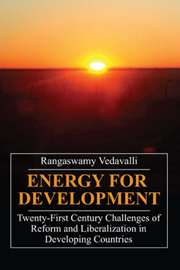 Energy for Development
Energy for Development Book contents
- Frontmatter
- Contents
- Abbreviations
- List of Tables
- List of Boxes
- Preface
- 1 The challenge of increasing access to energy for development
- 2 Changing global energy industry: implications for developing countries
- 3 Energy financing in developing countries in the pre-and post-1990s: towards energy sector reform and liberalization
- 4 Whither energy sector reform and liberalization in developing countries? A reality check
- 5 Energy sector reform and liberalization: case studies
- 6 Energy sector reform and liberalization and energy for the poor
- 7 Energy sector liberalization in developing countries: lessons and twenty-first century challenges
- 8 The way forward
- Bibliography
- Index
- Frontmatter
- Contents
- Abbreviations
- List of Tables
- List of Boxes
- Preface
- 1 The challenge of increasing access to energy for development
- 2 Changing global energy industry: implications for developing countries
- 3 Energy financing in developing countries in the pre-and post-1990s: towards energy sector reform and liberalization
- 4 Whither energy sector reform and liberalization in developing countries? A reality check
- 5 Energy sector reform and liberalization: case studies
- 6 Energy sector reform and liberalization and energy for the poor
- 7 Energy sector liberalization in developing countries: lessons and twenty-first century challenges
- 8 The way forward
- Bibliography
- Index
Summary
15 years after developing countries embarked on energy sector reform and liberalization, the promise of quick energy market transformation to attract private sector has proven illusory even in countries such as Argentina, Brazil and East Asian miracle countries. Since the late 1980s, developing countries ranging from Argentina in Latin America and China and India in Asia, to countries in Sub-Saharan Africa (SSA), launched energy sector reform as part of their economic liberalization program to attract private investment in their energy sectors. Attempted reform measures in the energy sector include liberalizing energy prices, establishing independent and transparent regulatory institutions, restructuring/ commercialization/ privatization and creating an environment to attract private investment in energy.
As of 2005, developing countries continue to face energy shortages and power black-outs persist. As the demand for energy increased, non-OPEC net oil exporters such as China turned to become net oil importer. There is little reduction in the number of over 2 billion people, accounting for over 40 per cent of the population in the developing world, who lack access to commercial energy. Even with slower rates of growth, the world's population will increase from 6 billion to 8 billion in 2050. The share of population in developing regions will increase from 77 per cent today to 85 per cent in 2030 and to over 90 per cent by 2050.
- Type
- Chapter
- Information
- Energy for DevelopmentTwenty-first Century Challenges of Reform and Liberalization in Developing Countries, pp. xix - xxiiPublisher: Anthem PressPrint publication year: 2007


